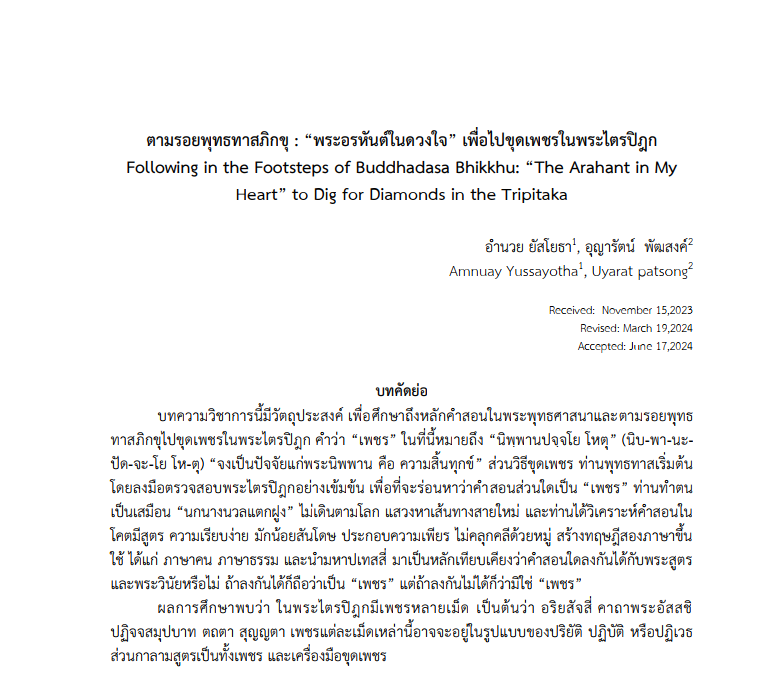Following in the Footsteps of Buddhadasa Bhikkhu: “The Arahant in My Heart” to Dig for Diamonds in the Tripitaka
Keywords:
Buddhadasa Bhikkhu, Diamond in the Tripitaka, seagull of self-realization and freedom, NirvanaAbstract
This academic paper intends to examine Buddhist teaching principles and follow in the footsteps of Buddhadasa Bhikkhu in his search for diamonds in the Tripitaka. The term “diamond” referes to "Nibbānapacayo Hotu" (nib-pā-na-pad-ja-yo ho-tu), which means “a factor for nirvana, liberating from all sufferings”. In terms of digging for diamonds, Buddhadasa first conducted an intense study of the Tripitaka to sift through and determine which parts of the teachings were “diamonds”. He acted as if he were “a seagull of self-realization and freedom” and sought his own path and fresh manner. The veteran pondered the teachings of the Gotami Sutta, practiced simplicity, contentment, isolation, and diligence, and preferred not to mingle with others. He developed the theory of two languages, human language and Dhamma language, and proposed the Mahapathesa 4 as a basis for determining which teachings were consistent with the suttas and discipline. If they adhered to the principle, they were referred to as "diamonds". However, if they were not compatible, they were not “diamonds”.
The study identified several diamonds in the Tripitaka, including the Four Noble Truths, Assaji mantra, Paticcasamuppada, Tathatā, and Sunyata. Each diamond can take the shape of pariyat, patibat, or patiwet. The Kalama Sutta encompassed both diamonds and diamond mining gear.
The author recommends that those interested in learning Buddhadasa’s concepts and philosophy of education management should use his teaching as a guideline for researching the Dhamma and recognize the courage to stand up for what is right, adhere to his moral principles as if a seagull of self-realization and freedom regardless of being outcasted by others, which is an ideal example for Buddhists.
References
ชิต ภิบาลแทน, (2520). ชีวิตและงานของพุทธทาสภิกขุ. กรุงเทพฯ : ศิลปาบรรณาคาร.
ประชา ปสนฺนธมฺโม และ สันติสุข โสภณสิริ. (ม.ป.พ.). ภาพชีวิต 80 ปี พุทธทาสภิกขุ.
ประชา ปสนฺนธมฺโม. (2529). ภาพชีวิต 80 ปี พุทธทาสภิกขุ : มิติใหม่ของพระพุทธศาสนา. กรุงเทพ ฯ : มูลนิธิโกมลคีมทอง.
ประชา ปสนฺนธมฺโม. (2546). อัตตชีวประวัติของพุทธทาสภิกขุเล่าไว้เมื่อวัยสนธยา (สัมภาษณ์). กรุงเทพฯ : มูลนิธิโกมลคีมทอง.
พุทธทาสภิกขุ. (2525). แถลงการณ์สวนโมกข์ 50 ปี และ กฎบัตรพุทธบริษัท. กรุงเทพฯ : สุขภาพใจ.
พุทธทาสภิกขุ. (2528). เพชรในพระไตรปิฎก. กรุงเทพฯ : กองทุนวุฒิธรรม.
สุธี สุดประเสริฐ. (2553). โปรแกรมตรวจหาและเทียบเคียง พุทธวจนจากพระไตรปิฎก (E-Tipitaka versin 3.1.4). [ซอฟต์แวร์]. จาก https://etipitaka.com
อดิศักดิ์ ทองบุญ. (2549). วาทะสำคัญของท่านพุทธทาส. วารสารราชบัณฑิตยสถาน, 31(4), 1050.
อรุณ แสงทอง. (2542). ธรรมวาทะของท่านพุทธทาส. กรุงเทพฯ : บุพนิมิตและสหายธรรม.
อำนวย ยัสโยธา. (2546). ภูมิปัญญาการนำทางสู่เนื้อธรรมของท่านพุทธทาส. กรุงเทพฯ : สำนักงานกองทุนสนับสนุนการวิจัย.









